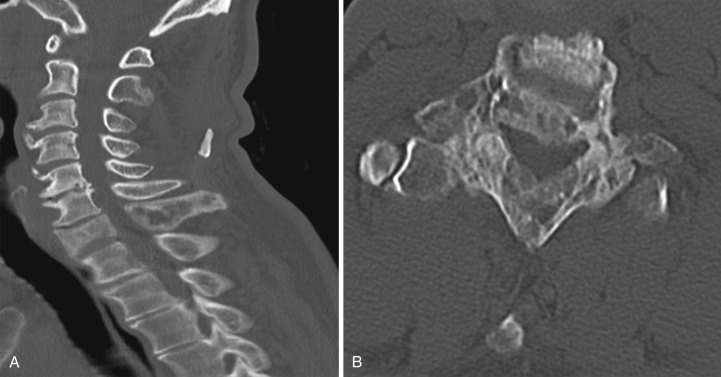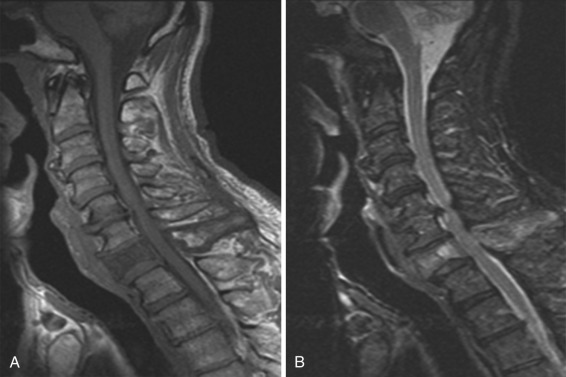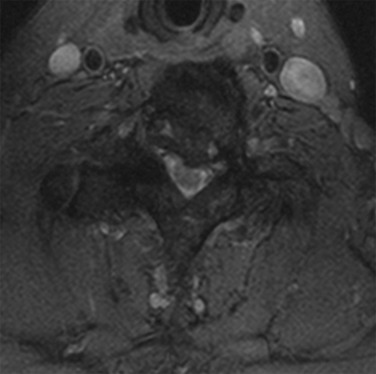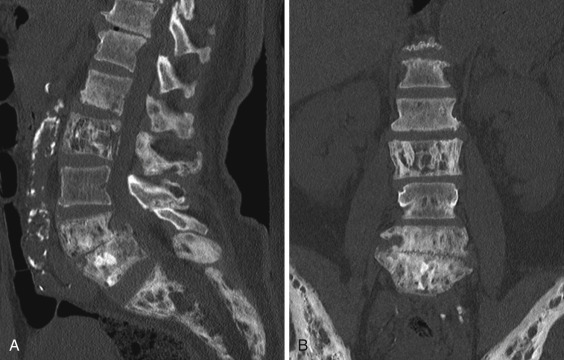Physical Address
304 North Cardinal St.
Dorchester Center, MA 02124
A variety of systemic diseases affect the osseous skeleton and therefore the spine. Detection of bone abnormalities with imaging can be challenging with plain film, given that demineralization, a common element of many conditions, requires a 50% decrease in bone mass before it can be detected. Computed tomography (CT) has improved the detection of demineralization, and magnetic resonance imaging (MRI) can enhance the sensitivity and specificity of detecting marrow abnormalities. Bone scan is a tool used to detect osteoblastic activity, a feature typically representative of the reparative process, although a primary lesion might have intrinsic elevation of osteoblastic activity.
Metabolic bone disease has a variety of causes and represents, as the name implies, conditions that result from some alteration of bone metabolism. In the normal adult there is a balance of osteoclastic and osteoblastic activity, resulting in neither a net decrease nor increase in the amount of bone. Thus an alteration in this balance results in abnormal bone resorption or bone deposition. In this chapter we will focus on some systemic diseases that have a characteristic appearance when they affect the spine. We will discuss Paget's disease of bone (PDB), renal osteodystrophy, myelofibrosis, and extramedullary hematopoiesis (EMH).
PDB (osteitis deformans) was originally described by Sir James Paget in 1877. PDB primarily affects the skull, spine, pelvis, and femur. The pelvis and spine are the most commonly affected sites, involved in 70% and 55% of cases, respectively. PDB is polyostotic in 66% of cases. PDB has osteolytic and osteoblastic phases, with the lytic phase predominating early on in the course of the disease process. It is a chronic disorder characterized by excessive and abnormal remodeling of bone often leading to osseous deformities. The etiology is unclear but likely multifactorial. There is epidemiologic data to support autosomal dominant trait. There are also published data suggesting a possible causative role by paramyxoviral infection. Paget's disease is a relatively common disease affecting the aging population, with affected individuals usually older than age 55 years at diagnosis. Patients younger than age 40 are rarely affected. The prevalence of PDB varies greatly between different countries; it is extremely rare in Japan and has approximately a 5.4% prevalence in the United Kingdom.
Imaging findings typically include enlarged vertebral bodies with trabecular thickening. There is usually involvement of the anterior and posterior elements. Characteristic vertebral body findings have been described as “picture frame” appearance secondary to central osteopenia and a peripheral coarse and thickened trabecular pattern ( Figs. 34-1 through 34-4 ). Findings may also include increased size and diffuse sclerosis of the vertebral body, referred to as “ivory” vertebra. Vertebral enlargement could lead to neural foraminal and/or central canal stenosis with associated neurologic symptoms (see Fig. 34-3 ). Contrast-enhanced CT or MRI may demonstrate significant marrow enhancement in the active or lytic phase. MRI usually demonstrates associated low T1 and T2 signal intensity, correlating to sclerotic bone. Areas of active lysis demonstrate increased T2 signal intensity (see Fig. 34-2 ). There is preservation of the normal marrow in unaffected areas. Bone scan may aid with polyostotic disease. “Mickey mouse” is a term that has been classically used to describe the inverted triangular radiotracer uptake classically noted in the involved vertebral bodies and pedicles. There is usually increased radiotracer uptake during the active phase.




Alkaline phosphatase, which reflects the level of new bone formation, is used as an adjunct in diagnosis and also plays a role in evaluating treatment response. However, it is nonspecific and values are normal in up to 15% of symptomatic patients with monostotic disease. Disease activity and response to therapy can be followed with measurements of alkaline phosphatase and other serum markers.
Basilar invagination, kyphoscoliosis, spondylosis, and fractures are the result of bone softening and secondary complications of Paget's disease of the spine. Sarcomatous degeneration involving the spine is rare, seen in less than 1% of cases and most commonly in patients with extensive disease. If there is interval change in imaging characteristics, soft tissue component, or increasing pain, further cross-sectional contrast-enhanced imaging should be performed to evaluate for rare sarcoma formation. Osteosarcoma is the most common type of sarcoma associated with Paget's disease, representing approximately 50% of cases; however, fibrosarcoma and chondrosarcoma are also described, with an incidence of 20% to 25% and 10%, respectively. Sarcomatous transformation is highly fatal, with a 3-year mortality rate greater than 90%.
Differential diagnosis for Paget's disease involving the spine includes metastatic disease and vertebral hemangioma. Although PDB has a distribution similar to metastatic disease, greater involvement of the ribs has been described with the former. There is also typically no enlargement of the affected osseous structures with metastatic disease. However, sometimes the distinction is difficult and biopsy is necessary. Vertebral hemangiomas have a delicate trabecular pattern, in contrast to the coarse and enlarged trabecular pattern seen in pagetoid bone. Additionally, typical vertebral hemangiomas demonstrate high T1 and T2 signal intensity on MRI, with no associated enlargement of the vertebral body.
Treatment of PDB is mostly targeted at symptomatic relief with analgesic medication. Medications that inhibit osteoclastic activity (e.g., bisphosphonate) also play a role. Surgical intervention is sometimes needed in symptomatic cases of neural foraminal or central canal stenosis.
Become a Clinical Tree membership for Full access and enjoy Unlimited articles
If you are a member. Log in here